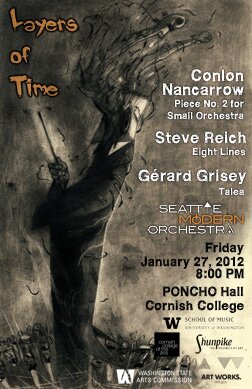Seattle Modern Orchestra Explores “Layers of Time” This Friday
The Seattle Modern Orchestra presents “Layers of Time,” a concert of contemporary classical works by Steve Reich, Conlon Nancarrow, and Gérard Grisey. The performance will be held on Friday night, January 27, at 8 p.m. at PONCHO Concert Hall on the Cornish College of the Arts Capitol Hill campus. More details and tickets are available at the Seattle Modern Orchestra website.
After a successful inaugural season, the Seattle Modern Orchestra is back with another year of concerts devoted to contemporary classical music. This Friday evening, the ensemble presents the second concert of their 2011-2012 season at Cornish College of the Arts’ PONCHO Concert Hall. The program, centered around the theme “Layers of Time,” features works by Steve Reich, Conlon Nancarrow, and Gérard Grisey.
Founded by conductor Julia Tai and composer Jérémy Jolley, the Seattle Modern Orchestra has helped fill a void in Seattle’s classical music scene with regular performances of contemporary classical works. The ensemble’s concerts are innovative and engaging, with a focus on making contemporary classical music accessible to a broad audience.
Tai and Jolley took a break from rehearsals for Friday’s concert to answer a few questions about the program and their approach to performing and listening to contemporary classical music.

The theme of Friday’s concert is “Layers of Time.” Although the element of time plays a role in all music, how does it uniquely factor into each of the three pieces on the program?
All three works from this concert present multiple tempos or musical meters simultaneously. In the first piece of our program, Nancarrow’s “Piece No. 2 for Small Orchestra,” each instrument or group of instruments maintains a different tempo, and therefore a different character. When they all play together, it creates very interesting effects. The second piece in the program, Steve Reich’s “Eight Lines,” features two layers of repetitive material (piano and woodwinds vs. strings) that evolve in very different musical time. In the third piece of our program, Gérard Grisey’s “Talea,” each instrument presents a single musical gesture in a different way.
What are some of the challenges of conducting and performing contemporary pieces like these?
Although all the pieces in the program use fairly traditional forms of notation, each piece was written in seemingly different musical languages. So for us musicians to perform these pieces, we almost have learn a new musical language for each piece. The good thing is, because of that, each piece has a unique sound and character.
Performing these pieces demands extreme musicianship from the musicians, including precise rhythm and subdivision, navigating sudden tempo changes, and playing quartertones and multiphonics that are not traditionally taught in music lessons. It is a lot of fun to be challenged, though.
What advice would you give a listener who is hearing these pieces for the first time?
Come with an open mind. What we are playing is very different from traditional concerts. It is interesting to hear the ideas of contemporary composers and how they create music in a new way.
There are a couple of listening tips we can give you while listening to the pieces. You can zoom-in your listening toward an instrument or group of instruments, focus on their individual melodies or rhythmic figure, and follow them to the end. Or, you can keep an on-going global listening approach and listen to the whole. You can try to find the relationship between each line. It’s like looking at contemporary paintings: You can stand close or stand back, and from each point of view you get a different understanding about the painting.
This is perhaps the goal of most contemporary composers: To give the audience a different way to listen to music, and therefore to listen to the world, regardless of the idea at the inception of the work.

 Daily Email Digest of The SunBreak
Daily Email Digest of The SunBreak